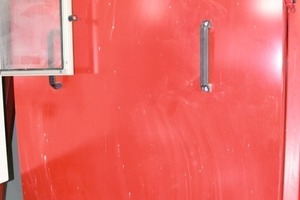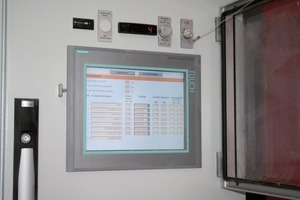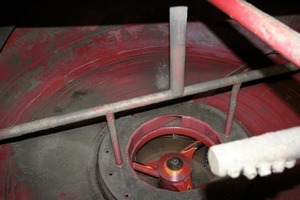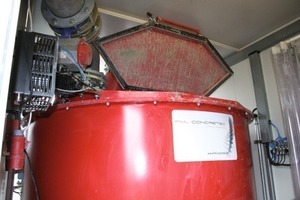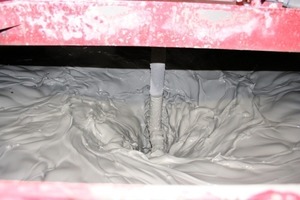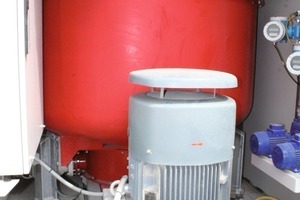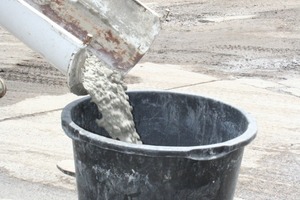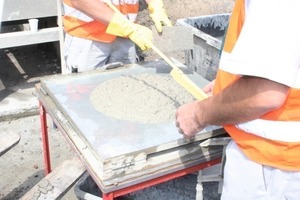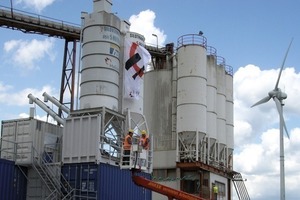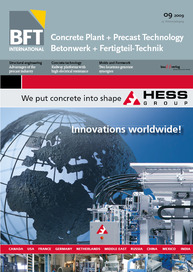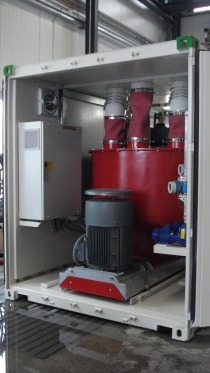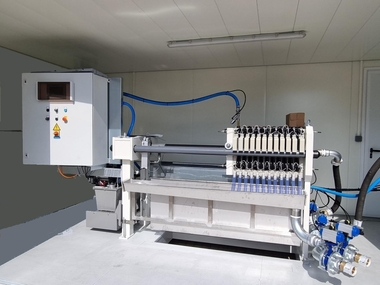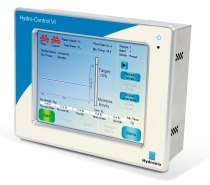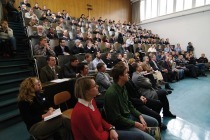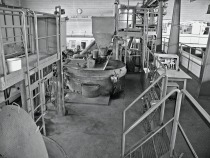Treated water creates optimized concrete
FML Concretec GmbH is a member of the FML Group active in the technological field of concrete production. FML has developed a new premium-concrete production method to market readiness. The FML process technology used also helps achieve significant cost savings whilst resulting in a considerable enhancement of quality. New routes of concrete technology can be explored by treating the mixing water immediately before its use and applying an entirely different mixing process. All stages of the FML Concretec process are protected by patents or other intellectual property rights.
Background
The cement industry actually is faced with daunting challenges which will continue in the years come. Cement consumption will increase further. Rising raw material costs and ever-stricter environmental regulations will continue to drive up both cost base and pricing levels. This is exactly where the new invention comes into play: the application of the FML Concretec technology significantly contributes to a resource- and cost-saving mode of operation whilst mitigating environmental impact. In the era of climate change and emissions trading, any conceivable activity to reduce the amount of raw materials required and to save energy is a step in the right direction.
This is why the entire traditional mixing process used in concrete production has been revised during several years of research by FML. The company succeeded in combining a physical water treatment system with a novel mixing technology as part of a new process. MAT has been enlisted as a cooperation partner supplying the patented colloidal slurry mixer. FML Concretec holds the patents for the water treatment method and the entire technique and process technology.
Large-scale unit in continuous operation
A first report on FML Concretec appeared in the April 2008 issue of BFT INTERNATIONAL already. The actual article reports on the installation of a large-scale prototype unit at a concrete plant in Northern Germany. We were offered the opportunity to witness the first industrial application of the FML Concretec technology. This first prototype was installed several weeks ago at the ready-mixed concrete plant operated by Holcim Beton und Zuschlagstoffe GmbH in Geesthacht. Since then, it has been operating parallel to normal production. The container system installed at this plant includes a water treatment unit, a 2,500 liter suspension mixer, the process control unit and the required dosing and batching systems.
Holcim and FML agreed that FML shall demonstrate the new process and technology in practical use. The parties jointly selected Geesthacht as the “launch site”. The installation of this large-scale system just off the city limits of Hamburg results in distinct benefits for both FML Concretec and Holcim. FML has the opportunity to test the new plant technology under any conceivable condition. In addition, the supplier may present the system in operation to international customers visiting the plant. The aspiring technology provider intends to utilize this installation and the associated presentation opportunities to prove the fitness of its process technology and expertise for practical use. A visit to the plant and the compelling demonstration of the improved fresh concrete characteristics will dispel any reservations that may still exist whilst creating an understanding of the technology and the opportunities it offers. Holcim is using this opportunity to work with various types of cement at the testing stage, which lasts several months, and to produce a large number of mixes for comparison and optimization.
The process
This technology combines an adjustable water treatment system with a colloidal mixing unit. For this reason, the patented suspension technology is available only in conjunction with the water treatment system. Core of the technology are the high-performance suspension mixing unit and an integrated electric and/or electro-dynamic water treatment process.
By the FML method, water is physically broken down to individual molecules in the first process step. In addition, the charge of the separated water molecules is altered in such a way that they can link to the binder constituents more easily. The FML water treatment system is the first pass-through system available on the market that can be tailored to specific customer needs. Other water treatment units cannot be adjusted or controlled as it would be essential for a successful process.
An intermediate tank has been integrated in the water treatment system. The amount of water contained in this tank is needed to ensure perfect water treatment and a reasonably quick dosing pattern at a defined flow volume and velocity. This principle also prevents disruptions or malfunctions that may otherwise occur, for instance due to fluctuations in water pressure. The duration of treatment is one of the important parameters that influence the targeted physical treatment of the water.
The FML Concretec mixing process also decomposes the binder constituents. This effect provides the opportunity to use lower-strength cement grades (such as CEM 32,5 instead of CEM 42,5), which correspondingly results in cost savings. The reduced milling cost and effort at the cement plant also leads to a significant reduction in energy consumption and carbon emissions during cement production, which is why this process is an attractive option not only for the concrete but also for the cement industry.
In the specially designed mixer, water and reactive constituents (binders, admixtures and additives if required) are mixed at high speed. During this mixing process, the binder agglomerations are broken down and the binder particles get further separated to a certain extent. Shear forces are introduced into the slurry by cavitation. The typical mixer motion creates a vacuum and results in an implosion of particles directly behind the mixer paddles. The mixing system ensures optimal energy input and use, and thus a very quick and complete activation of any admixtures used.
In the last process step, non-reactive fillers (i.e. sand and gravel/grit) are mixed with the slurry in the existing mixer of the concrete plant (or directly in the truck mixer). This final mixing process requires only a low amount of energy.
There is a large number of other advantages that concrete producers will be able to gain when applying this technology, such as better concrete placement, SCC that can be produced with a lower amount of additives, almost pore-free concrete surfaces, no segregation of fresh concrete, a significantly lower amount of water required, a reduction in energy cost, the production of special concretes in conjunction with polystyrene, timber or glass.
The concrete mix
During our visit, both the production of a mix with the FML Concretec method and the production of a “conventional” factory mix used as a “zero” reference mix were commissioned.
The FML mix was produced in the process steps referred to above: Following the selection of concrete grade and volume, the required amount of water stored in the control system was treated physically. The treated mixing water was fed into the mixer via large inlets within a short period. One after another, cement and fly ash for 8 m³ of concrete were conveyed into the suspension mixing unit. After only a few (< 5) minutes of mixing, the slurry had been completely mixed and could be used for the further concrete production steps.
In the meantime, a truck mixer was filled with the aggregates specified in the mix design for 8 m³ of concrete. This mixer then pulled over to the area underneath the outlet of the Concretec mixing unit. In the next step, the slurry was fed directly into the moving drum via the hopper. Finally, slurry and aggregates were mixed for a further period of about 2.5 minutes. This is why this phase is also called “homogenization”. At the end of the final mixing period, a concrete produced in the FML process left the drum mixer – this concrete had a slump flow of a0 = 675 mm and was thus significantly softer/more flowable than the conventional concrete that was produced at the same time (a0 = 550 mm).
The required fresh concrete tests were carried out on the site. To compare the two concrete mixes, their slump flows after 0, 30 and 60 minutes and were measured. In addition, the temperature and bulk density of the fresh concrete and its air void ratio were determined. The “concrete monitoring” system is complemented by compression tests performed on cubes in the laboratory at a later stage.
Fig. 8 and 9 show the results for the two types of concrete. The use of the FML Concretec technology resulted in a significant improvement of the characteristics of both fresh and hardened concrete.
It was proven that the optimized mix design offered double-digit savings potentials as regards the amount of raw materials required.
Cooperation
The FML Concretec system, however, is not only based on an improvement of quality by water treatment and a modified mixing process. It also includes the costwise optimization of the customer‘s mix design. Only this holistic approach makes it possible to achieve the best possible modification of the concrete mix. Any associated savings potentials will be determined. A site visit or at least a transfer of all available infromation on the production is the starting point of any such project-based cooperation with FML Concretec. Subsequently, the customer is requested to submit samples of the binders, aggregates and additives used, as well as the different mix designs. The supplied materials will then be mixed in the laboratory on base of the original customer‘s mix design. In the next step, FML Concretec optimizes the mix and calculates the resulting savings potentials.
Identical testing parameters are applied to all preliminary tests during which FML assists the concrete producer with adjusting the mix design. At the beginning, the laboratory mixer (which is also a colloidal mixer) is used to produce a zero reference mix. This is followed by the same mix but with the addition of treated water. As the last modification in this series, the initial mix is produced using treated water and a slurry. Once the test results are available, the mix design can be optimized. The optimized mixes are then evaluated as regards their fitness for practical use.
Large-scale units such as the one installed at the plant in Schleswig-Holstein can be delivered within a few months. As a matter of fact, however, each large-scale system requires a certain “ramp-up” period. During this phase, FML provides the customer with its technical knowledge in terms of a customer service package which is an integral part of the delivery, and assists with the adjustment to the existing conditions and the modification of mixes.
In specific cases, tests may be carried out at the customer’s laboratory. However, the preferred option in terms of the technical and organizational framework provided is to perform these tests at the FML Technology Center in Adendorf (near Hamburg), which is a concrete laboratory that is well-equipped for all tests pertaining to building materials and concrete technology. Several thousand concrete mixes have been produced already both at this facility and on customer sites.
Range of applications
The newly developed process enables producers to utilize the hidden potentials of existing concrete mixes. One of the key factors in this regard is the milling of the cement, which can be carried out during the suspension mixing process. The resulting finer cement can then be used to increase the early strength of the concrete. Alternatively, coarser cement grades in lower strength classes can be upgraded.
The combined FML Concretec system is especially economical in concrete plants with a high annual output and for major projects.
The various sectors of the concrete industry are faced with specific issues that can be resolved by this novel system. The workability of readymixed concrete, for instance, can be noteably improved and sustained for a longer period.
Special concretes which currently can only be manufactured by adding a higher amount of high-strength cement can now also be produced exactly to specification with “normal” cement grades – thanks to the FML technology. The precast industry is thus provided with the option of not necessarily having to use special FT[SW2] cements in each and every case. Another key benefit is the shortened mixing time. The FML technology also demonstrates its advantages when producing hollow-core slabs on slip-formers or extruders. Other potential fields of application are ECC (easily compactible concrete) and SCC (self-compacting concrete). In these cases, the application of the FML Concretec process results in the most significant savings compared to the conventional production of ECC/SCC. Savings potentials and opportunities for product improvements also exist in concrete pipe, frame, manhole, paving block and slab production.
The cost base can be reduced significantly in all concrete-producing sectors.
Outlook
If required, FML will utilize the resources provided by IFF Weimar and carry out tests at the IFF pilot facility to perform specific laboratory tests of concretes that are used in the above-mentioned fields of production and processed using certain mechanical compaction methods.
At the institute, the specific production and curing conditions prevailing in the precast industry would be taken into account. Amongst other factors, these include the heating of aggregates, water and molds or formwork. Compared to the production and storage of test cubes in accordance with the applicable standard, this setting provides the advantage that conditions close to reality can be simulated. The conditions required to store specimens in heated premises are currently being implemented also at the pilot facility operated by FML in Adendorf. FML Concretec will soon have taken another step: Following additional series of tests, the company will be able to define a correlation between laboratory findings and outcomes that can actually be achieved at the factory. These results will allow interpolations and reliable forecasts of anticipated fresh and hardened concrete properties.
Another idea of this aspiring company is that concrete producers act as service providers to building contractors by setting up a “suspension service station” directly on the project site. This concept relies on the installation of a complete FML suspension mixing unit consisting of water treatment unit, colloidal mixer and control system (for instance as a container version) in a strategically beneficial location. At this “service station”, the truck mixers after having been loaded with the weighed aggregates (20-25% higher payload!) fill up with the required amount of binder suspension. Applying this principle, each drum mixer is converted into a homogenization unit and can produce the final concrete mix just in (short) time and at maximum load capacity. This results in a quality improvement, prevents a number of known issues and leads to both raw materials costs and transport cost savings.
Summary
The major savings potentials which can be gained result from the possible lower w/c ratio and/or the option to replace cement with limestone powder, fly ash or preferred local substitutes (fine aggregates). The system also allows the use of lower-strength cement grades to achieve the same performance parameters. In addition, the influence of additives (such as plasticizers or workability agents) can be reduced significantly. The reduced absolute energy consumption is also a strong argument in favor of the system.
Finally, the FML technology now also allows the production of premium-quality F6 concretes or SCCs exactly to specification and with good flow properties during the entire processing and placement period. Another key benefit is provided by the stability of the mix – segregation does not occur even in flowable types of concrete. In most cases, the process allows for a reduction in the amount of plasticizers/concrete workability agents and/or fillers used, which usually results in sizeable cost savings.
However, it is not always possible to realize all of the above benefits in a “package”. It is therefore advisable for the customer to define its primary objectives. These are then taken into account as far as reasonably possible throughout the management of the project. The components of the system don’t necessarily need to be installed in a container. They may also be delivered individually and integrated in existing plants or production lines. FML water treatment systems can also be installed on their own, i.e. without the colloidal mixing unit. The combined system is, however, the best option to maximize the effect of optimization.
Address/Anschrift
FML Concretec GmbH
Walter-Rathenau-Str. 38
35745 Herborn/Germany
Tel.: +49 2772 572330
Fax: +49 2772 576658
Address/Anschrift
FML Concretec GmbH
Walter-Rathenau-Str. 38
35745 Herborn/Germany
Tel.: +49 2772 572330
Fax: +49 2772 576658
info@fml-concretec.de
www.fml-concretec.de

